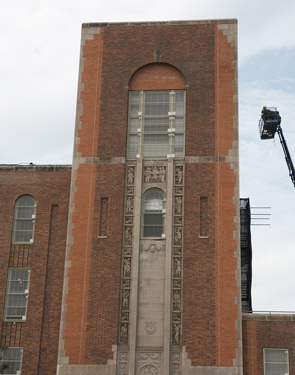Samuel Gompers Career and Technical Education High School

Formerly Samuel Gompers Industrial H.S. for Boys
Wales Avenue and East 145th Street
Walter C. Martin
1933
In place of the steps and porticoed doorway we would expect at the front of a 1930's high school, we’re met at street level with an iron gate and truck-wide driveway. It leads through the front wall into a courtyard, not planted but paved. (Originally, large workshops opened onto it.) From either side, twin six-storey towers survey the yard. A tall square brick chimney shamelessly pokes up at the rear. Outside again, a walk around the corners, past block-long brick walls with repeating columns of narrow windows, will confirm the impression: this school is meant to look like a factory. Samuel Gompers HS, purpose-built as an “industrial” public high school, was the first such institution to focus its training on a single industry-the electrical, rather than on multiple trades, preparing students for the integrated labor of mass production. Its building appropriately represents a “general electric” plant.
But that’s not the whole story. Presenting the plans for Gompers in 1930, Walter C. Martin touted the school’s “modernistic type of architecture,” the latest advance in his campaign to introduce a new style, “specially adaptable to school buildings.” It’s hard to know exactly what Martin, the Superintendent of School Buildings, meant by “modernism.” He seems to have been most interested in practicalities, avoiding “historical” building types and their trimmings, columns or Gothic tracery which restricted efficient window placement. Sometimes this meant opting for the low-relief facades of Art Deco. At Gompers his staff took a much more radical approach, in effect planing away all surface detail, and reducing all shape to an elementary cubic geometry. What remains is a balanced arrangement of blunt, distinct blocks. There are no cornices or moldings or visible roofs: planes of brick terminate in sharp edges, emphasized by smooth limestone quoining. The walls are evenly patterned by vertical columns of windows and spandrels, recessed between flat piers, a grid which not only implies the steel structure beneath, but measures out the perfect proportions of the building’s sections.
These economies of form were consistent with contemporary European architecture, which idealized the rationality of engineering and manufacturing. As Gompers was built, American admirers were echoing Le Corbusier’s notorious dictum “a house is a machine for living in” with the proposition that a school “must be to a certain extent, industrial in character as it is a machine for education.” (School Buildings of Today and Tomorrow, 1931). So the factory-like arrangement of the industrial school and the pursuit of “modernism” by its designers are tightly related.
Gompers is not quite as austere as these constraints suggest. In compensation for the absence of raised ornament, it provides an impression of channels, chiseled-out vertical spaces. The pattern is set by the long shallow recesses of the arched window bays, and repeated in the enlarged bay which forms a broad niche down the face of each tower. Within these latter cavities, a compressed, intaglio decoration flourishes. Terracotta panels of bas-relief are inlaid along the edges, illustrating the varieties of industrial work. Limestone sheathing carries emblematic roundels and finely-lettered adages. And at the foot of the niches, just above the entrances to the towers, pairs of sculpted lions’ heads are actually permitted to protrude beyond the wall —a unique exception to the rule, a clever grace note.
David Bady
Photographs:
Abigail McQuade

